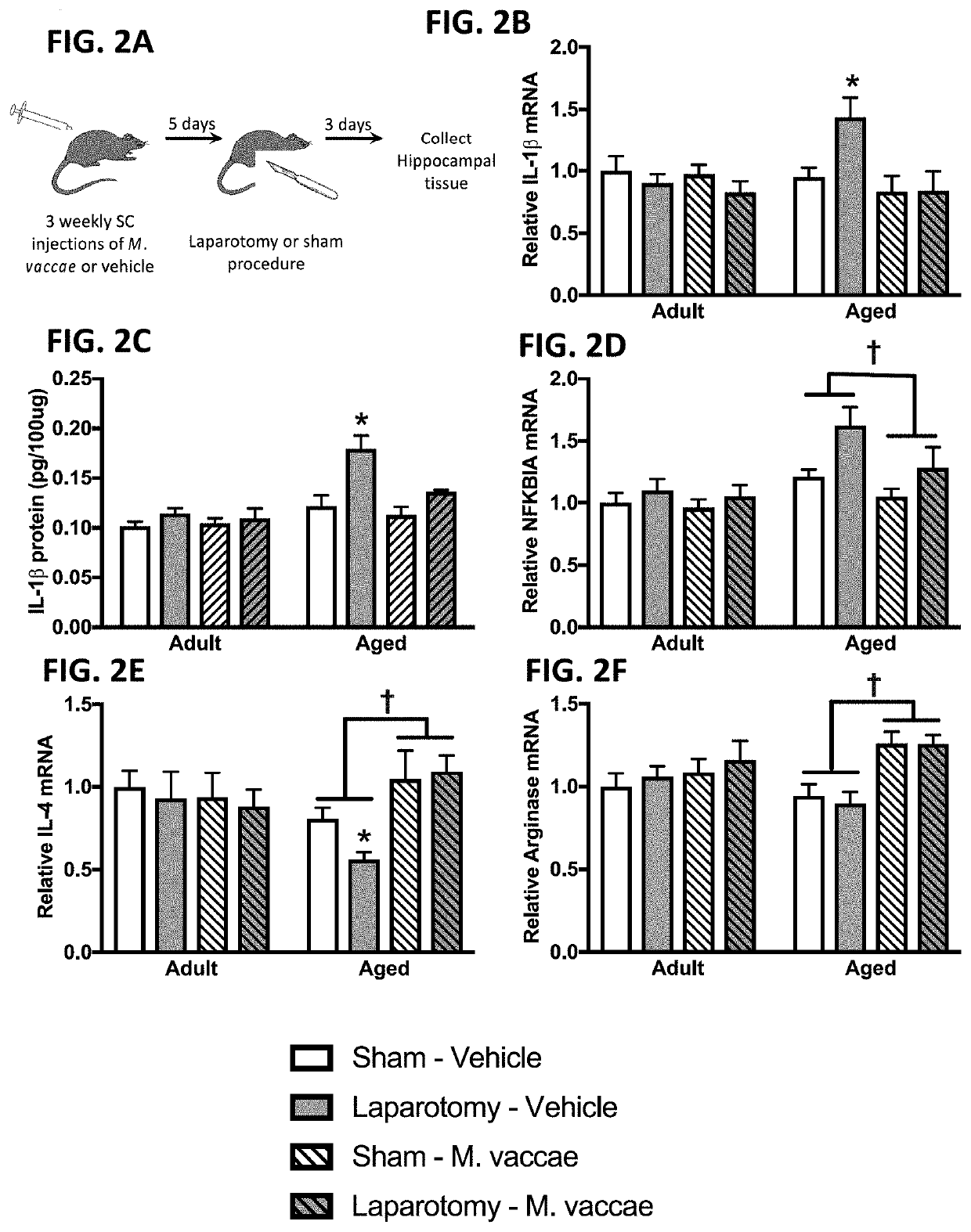Protection from Stress, Anxiety, Neuroinflammation, and Cognitive Dysfunction
a neuroinflammation and cognitive dysfunction technology, applied in the field of neuroinflammation, can solve the problems of high chronicity, high chronicity, and aging is a significant risk factor for cognitive decline, and achieve the effects of increasing interleukin (il4)4, increasing il4 protein, and reducing cd200r1
- Summary
- Abstract
- Description
- Claims
- Application Information
AI Technical Summary
Benefits of technology
Problems solved by technology
Method used
Image
Examples
example 1
a Major Risk Factor for Developing Postoperative Cognitive Dysfunction (POCD)
[0107]The following materials and methods were used to conduct the experiments described in this Example:
[0108]Animals: Adult (3 months) and aged (24 months) male F344XBN F1 rats were used in these experiments. Rats of this age and strain were selected to study healthy, non-neurodegenerative aging (these rats live for >30 mos). Rats were received from NIA and pair-housed (52 cm L×30 cm W×21 cm H) with an age-matched conspecific. Food and water were available ad libitum and rats were maintained at an ambient temperature of 22±2° C. on a 12:12 light cycle with lights on at 0700. Upon arrival, rats were acclimated for 7+ days prior to any experimental manipulation.
[0109]Experiment 1: Does M. vaccae immunization protect aged rats against surgery-induced memory impairments? Adult and aged rats (n=6 / group) received three subcutaneous injections of M. vaccae or vehicle spaced one week apart (i.e., one injection pe...
example 4
Increased T Cell Markers in the Hippocampus
[0126]The peripheral anti-inflammatory effects of M. vaccae have been largely attributed to effects on T cells but T cells are not routinely detected in the brain parenchyma as access is tightly regulated by the blood-brain barrier. Here, the inventors showed that mRNA expression for the pan T cell marker, CD3, is upregulated in the hippocampus of aged rats and reduced by M. vaccae immunization (age×M. vaccae F1,45=8.6, 1,45=90.9, pM. vaccae treatment in aged subjects (age: F1,45=5.2, M. vaccae: F1,45=4.7, pM. vaccae treatment shifts the population of T cells gaining access to the CNS.
Example 5: M. vaccae Immunization Dampened Inflammatory Responses of Aged Microglia Ex Vivo
[0127]Microglia are considered the predominant innate immune cell of the CNS and a key cellular substrate of aging-induced neuroinflammatory priming. Therefore, the inventors examined whether in vivo M. vaccae immunization in aged rats reduces ex vivo microglia reactivit...
example 6
on of Stress-Induced Microglial Priming, Alarmins, And Anxiety-Like Behavior
[0129]The following materials and methods were used to conduct the experiments described in this Example:
[0130]Animals: Adult male Sprague-Dawley rats (60-90 d old) were pair-housed with food and water available ad libitum. The colony was maintained at 22° C. on a 12 h light / dark cycle (lights on at 07:00 h).
[0131]M. vaccae treatment: M. vaccae is a saprophytic environmental Mycobacterium, which we have used previously to mitigate stress-induced anxiety-like behavior and peripheral proinflammatory responses. Briefly, whole heat-killed M. vaccae (strain NCTC 11659, batch ENG 1; Bio Elpida; 10 mg / ml) was suspended in sterile borate-buffered saline (BBS) to yield a final concentration of 1 mg / ml. Sterile BBS served as the vehicle control. Consistent with our prior work with M. vaccae, experimental animals received 3× subcutaneous (s.c.) immunizations with 0.1 mg whole heat-killed M. vaccae suspension (0.1 ml) o...
PUM
| Property | Measurement | Unit |
|---|---|---|
| concentration | aaaaa | aaaaa |
| concentration | aaaaa | aaaaa |
| concentration | aaaaa | aaaaa |
Abstract
Description
Claims
Application Information
 Login to View More
Login to View More - Generate Ideas
- Intellectual Property
- Life Sciences
- Materials
- Tech Scout
- Unparalleled Data Quality
- Higher Quality Content
- 60% Fewer Hallucinations
Browse by: Latest US Patents, China's latest patents, Technical Efficacy Thesaurus, Application Domain, Technology Topic, Popular Technical Reports.
© 2025 PatSnap. All rights reserved.Legal|Privacy policy|Modern Slavery Act Transparency Statement|Sitemap|About US| Contact US: help@patsnap.com



